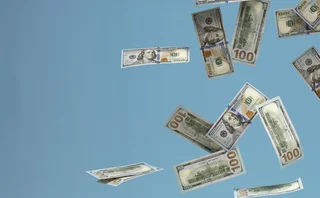When Bubbles Burst, Remember the Tulips
Could big data analytics have prevented Tulip mania?

The first speculative bubble to burst in history had nothing to do with housing, shipping or petrol...it had to do with pedals, or tulips, to be exact.
As is documented in journalist Charles Mackay's 1841 book Extraordinary Popular Delusions and the Madness of Crowds, the price of tulips skyrocketed in 1635 as the popularity of these flowers exploded for no real reason.
After reaching its peak in February 1636, the price proceeded to plummet, bottoming out three months later. This became known as "Tulip mania". Many of the economic ideas expressed by Mackay were countered in the late 20th century, but the idea of speculative bubbles dates back all the way to this event.
Flash forward to China's cratering market and the correction currently underway in the US. My colleague Peter Madigan, who is an editor at Risk magazine, was using the example of Tulip mania to help explain what we're seeing today and how the irrational exuberance of crowds can lead to bubbles, and the subsequent bursting of bubbles. I'd never heard of Tulip mania ─ how can something that has no intrinsic value balloon in price at an out-of-control rate...and then I remembered my baseball card collection ─ and thought it would be interesting, even if more of a thought exercise.
It might be easy to simply say that what is happening in China is the direct cause of what we're seeing in the US. But Nobel Laureate Robert Shiller told PBS that it's human nature that explains the market volatility in the US, not necessary China...and this connects to Tulip mania. As he told PBS:
I would say that a speculative bubble rises upon investor enthusiasm, and when it becomes too big, many people begin to have their doubts and contemplate selling, but don't have clarity enough to actually do it," Shiller told PBS. But when they see the market dropping, they begin to fear that others have the same doubts, and so many of them hurry up, trying to sell before the others do. So, the downswing can be surprisingly fast, recalling the bursting of a bubble, even if it is not quite as sudden as that.
I cannot imagine the news from China could provide a rational explanation for the drop in world markets. The news from China is too subtle, not that dramatic and sudden. But the story has been put forth by the news media as if it were suddenly extremely important, as part of a general pattern of news media and investor advice hype. In our new book "Phishing for Phools: The Economics of Manipulation and Deception," George Akerlof and I use the word phishing more broadly than usual to describe such behavior. A phool is someone, who may be highly intelligent, but who does not see that he or she is a phish. A lot of people who bid up stock prices to such high levels were phools.
Shiller developed the Cyclically-Adjusted Price-Earnings (CAPE) Index, which measures the price of a stock to its earnings over a 10-year period. He had predicted the recent housing collapse and is not surprised by this recent market adjustment, saying that the CAPE index was at 27 in July, which "is higher than at any time around 1929, 2000 and 2007." He also says that no one can forecast what will happen in the stock market tomorrow.
Big Data Surveillance
While Waters covers the financial world, we're a technology publication. A stock going up or down has little to do with tech, so when I see these wild fluctuations, if there's not a software glitch involved, I worry more about my 401(k) and not about writing a story.
Where we're most concerned is when it comes to Flash Crashes and circuit breakers, but my colleague Tim Bourgaize Murray already beat me to the punch on that story. (I highly recommend you read it, because it's an interesting think piece on whether or not circuit breakers should be involved in a "free market".)
But what I wonder is whether or not big data analytics can serve as a surveillance tool to help defend against these bubbles, or if human nature will always spin out of control and drive up prices, regardless of what the data warns against.
Surveillance tools can monitor for a large swath of market participants trying to get into the same stock and send up a red flag. But is there also a way to find bubbles using Google searches and monitoring historical prices of a commodity much in the same way as Shiller's CAPE Index?
In case it wasn't obvious yet, I have no real answer here. What I'm proposing might be dumb, or it might already be available today — we've seen at least a few who claim their analytics can predict the whims of human behavior.
I'm not an economist and I'll never fully understand the creation or bursting of bubbles. But I also know that somewhere in all this economic data that's being produced is information that may not predict, but that can give a strong indicator, as to where the next bubble is developing.
If only they had machine learning and natural-language processing technologies back in 1636.
Only users who have a paid subscription or are part of a corporate subscription are able to print or copy content.
To access these options, along with all other subscription benefits, please contact info@waterstechnology.com or view our subscription options here: https://subscriptions.waterstechnology.com/subscribe
You are currently unable to print this content. Please contact info@waterstechnology.com to find out more.
You are currently unable to copy this content. Please contact info@waterstechnology.com to find out more.
Copyright Infopro Digital Limited. All rights reserved.
As outlined in our terms and conditions, https://www.infopro-digital.com/terms-and-conditions/subscriptions/ (point 2.4), printing is limited to a single copy.
If you would like to purchase additional rights please email info@waterstechnology.com
Copyright Infopro Digital Limited. All rights reserved.
You may share this content using our article tools. As outlined in our terms and conditions, https://www.infopro-digital.com/terms-and-conditions/subscriptions/ (clause 2.4), an Authorised User may only make one copy of the materials for their own personal use. You must also comply with the restrictions in clause 2.5.
If you would like to purchase additional rights please email info@waterstechnology.com
More on Emerging Technologies
Market data costs defy cyclicality
Trading firms continue to grapple with escalating market data costs. Can innovative solutions and strategic approaches bring relief?
As trading firms embrace AI, so do hackers
According to a Google cybersecurity report, cybercriminals are turning to AI to sharpen their attacks.
AI & data enablement: A looming reality or pipe dream?
Waters Wrap: The promise of AI and agents is massive, and real-world success stories are trickling out. But Anthony notes that firms still need to be hyper-focused on getting the data foundation correct before adding layers.
Waters Wavelength Ep. 343: Broadridge’s Jason Birmingham
This week, Jason Birmingham of Broadridge talks with Tony about the importance of fundamentals as technology rapidly evolves.
Data standardization is the ‘trust accelerator’ for broader AI adoption
In this guest column, data product managers at Fitch Solutions explain AI’s impact on credit and investment risk management.
BNY inks AI deal with Google, Broadridge moves proxy voting to AWS, Expero delivers ICE market data, and more
The Waters Cooler: TSX Venture Exchange data hits the blockchain, SmartTrade acquires Kace, and garage doors link to cloud costs in this week’s news roundup.
Everyone wants to tokenize the assets. What about the data?
The IMD Wrap: With exchanges moving market data on-chain, Wei-Shen believes there’s a need to standardize licensing agreements.
Google, CME say they’ve proved cloud can support HFT—now what?
After demonstrating in September that ultra-low-latency trading can be facilitated in the cloud, the exchange and tech giant are hoping to see barriers to entry come down.








